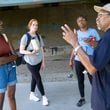ART REVIEW
“Michi Meko, Pursuit: Almost Drowned”
Through Aug. 8. 10 a.m.-6 p.m. Tuesdays-Fridays; 11 a.m.-5 p.m. Saturdays. Alan Avery Art Company, 315 E. Paces Ferry Road. 404-237-0370, www.alanaveryartcompany.com.
Bottom line: The South looms large in this solo exhibition from an Atlanta artist with an increasingly sophisticated point of view.
Atlanta artist Michi Meko has often treated race in his work. But like many other area artists dealing with the South's troubled history, instead of anger and controversy, Meko offers something more nuanced. His paintings and sculptures show the complexity of living in the South, and being both of the South but also deeply critical of its checkered past.
The longtime Atlanta artist's solo exhibition "Pursuit: Almost Drowned" at Buckhead's Alan Avery Art Company traffics in expressions of mourning and inquiry in works that often treat race in subtle rather than overt ways.
This visually rich show is a mix of assemblage sculptures and paintings, as well as works on paper whose worked-over palimpsests of color and line convey a strong sense of the past. Their weathered, degraded appearance is one way Meko gets at his mission in “Pursuit”: to examine an emotional continuum of the African-American experience and show how a smart, urban black man who lives in the present also contends with the past’s legacy.
Meko’s work definitely casts a powerful spell, in many ways because it is so poetically oblique. Instead of frank references to slavery or segregation, there are numerous evocations of the terrible nightmare of drowning, of limitless sky and sea and no escape. In sly symbols and abstracted storytelling, Meko tells stories of death by fire in “Coincidence,” where charred black wood, a funeral parlor fan and slashes of orange, rust, red and gold suggest a devastating conflagration.
In these works, there is fire on one side and water on the other, with a troubling suggestion of nowhere to turn. Many of these artworks use nautical elements to subtly reference the passage by ship of African slaves to America.
Drowning is a constant refrain in “Pursuit,” in paintings like “November Charlie” where a figure floats in a corpselike posture in the water. All around him, the bright colors of what look like maritime signal flags convey distress. Meko’s canvases are punctuated by horizons divided into sky above and consuming black sea below. But Meko is not just visualizing literal drownings — he also treats metaphorical ones. Floating or sinking conveys a profound sense of fatalism in “Pursuit,” a sense of inescapable despair.
Some of the most haunting and beautiful works in “Pursuit” are also the simplest, as in a series of spare mixed-media works on paper. In “The Science of Buoyancy,” “The Kit” and “The Loner,” extraneous detail is removed and single floats and buoys bob in the water, as lonely stand-ins for people carried along on fate’s currents.
Meko has come a long way from the slightly cutesy neo-folk art he made in the past, often done in partnership with his frequent creative collaborator John Tindel.
In these works, Meko has taken a more reined-in approach, cutting back his visual references in order to amplify their power. His sculptural works suggest totems to ward off bad luck or see one through difficult circumstances. “The Kit” suggests a papoose or backpack loaded with some of the markers of Southern life: cotton bolls, a handmade quilt, a dried gourd, burlap and a Mason jar lid.
In his material and approach, Meko makes his Southern genesis clear. A Jean-Michel Basquiat for the collards and cornbread set, Meko weaves in touchstones of Southern heritage that show a sensibility shaped by his birthplace, for better and for worse.
About the Author





